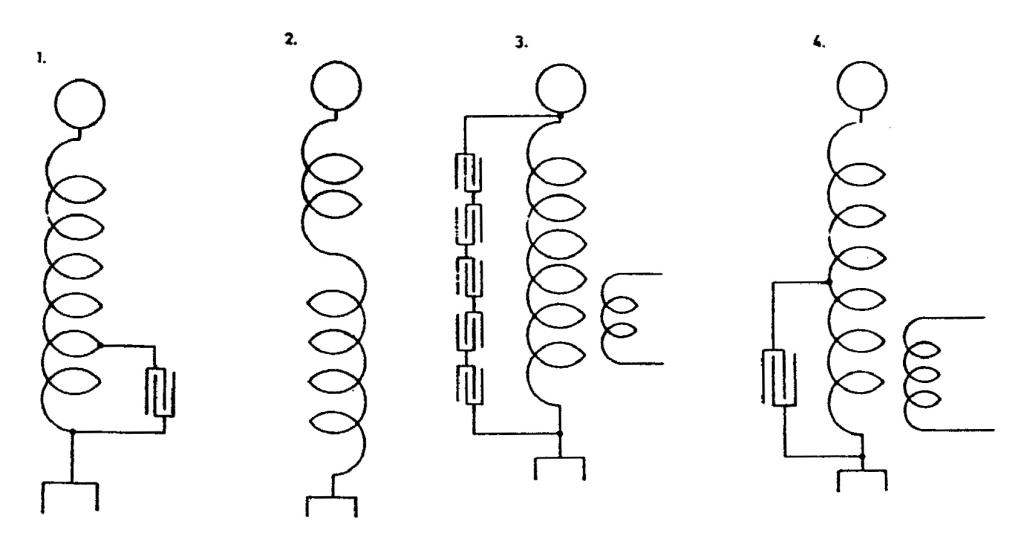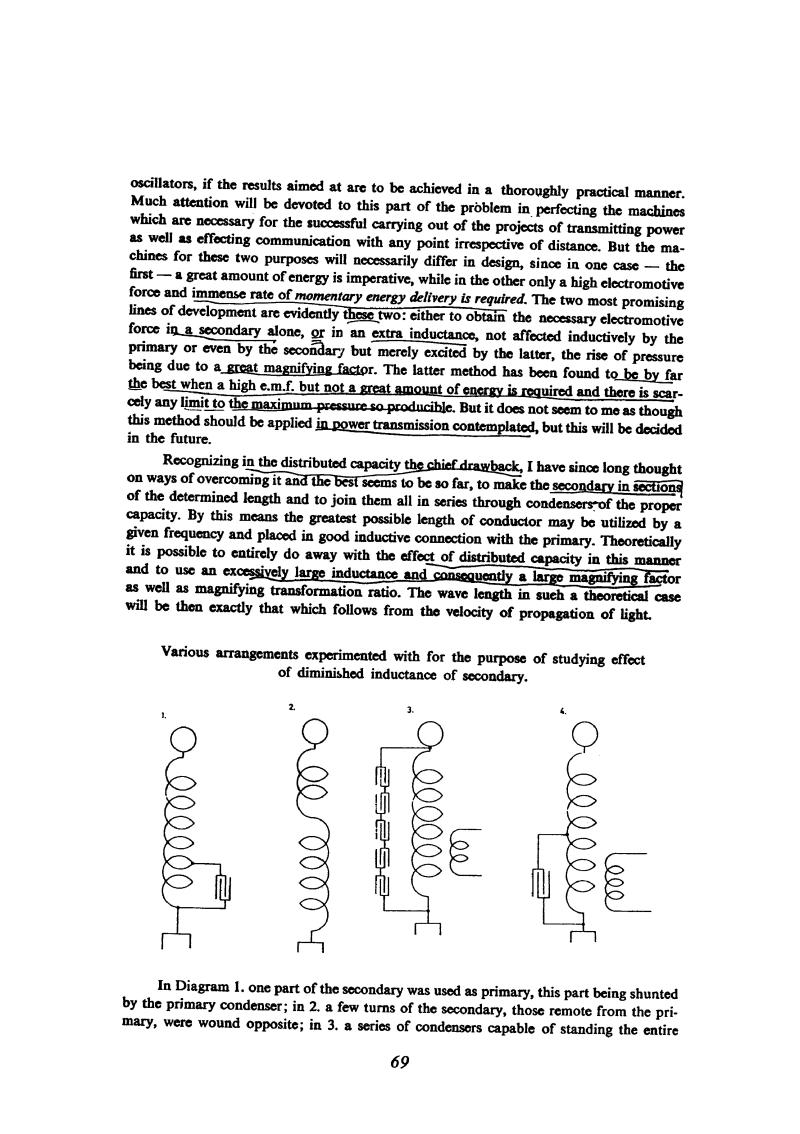
Nikola Tesla Books
oscillators, if the results aimed at are to be achieved in a thoroughly practical manner. Much attention will be devoted to this part of the problem in perfecting the machines which are necessary for the successful carrying out of the projects of transmitting power as well as effecting communication with any point irrespective of distance. But the machines for these two purposes will necessarily differ in design, since in one case - the first - a great amount of energy is imperative, while in the other only a high electromotive force and immense rate of momentary energy delivery is required. The two most promising lines of development are evidently these two: either to obtain the necessary electromotive force in a secondary alone, or in an extra inductance, not affected inductively by the primary or even by the secondary but merely excited by the latter, the rise of pressure being due to a great magnifying factor. The latter method has been found to be by far the best when a high e.m.f. but not a great amount of energy is required and there is scarcely any limit to the maximum pressure so producible. But it does not seem to me as though this method should be applied in power transmission contemplated, but this will be decided in the future.
Recognizing in the distributed capacity the chief drawback, I have since long thought on ways of overcoming it and the best seem to be so far, to make the secondary in sections of the determined length and to join them all in series through condensers of the proper capacity. By this means the greatest possible length of conductor may be utilized by a given frequency and placed in good inductive connection with the primary. Theoretically it is possible to entirely do away with the effect of distributed capacity in this manner and to use an excessively large inductance and consequently a large magnifying factor as well as magnifying transformation ratio. The wave length in such a theoretical case will be then exactly that which follows from the velocity of propagation of light.
Various arrangements experimented with for the purpose of studying effect of diminished inductance of secondary.
In Diagram 1. one part of the secondary was used as primary, this part being shunted by the primary condenser; in 2. a few turns of the secondary, those remote from the primary, were wound opposite; in 3. a series of condensers capable of standing the entire
69
July 8
Detailed consideration of high frequency transformer is actually a resume of obtained experiences and theoretical thoughts. In order to achieve the goal - the machine of higher power and voltage, Tesla looks for methods to optimize all oscillator details; arcing device, primary and secondary inductances, mutual inductance and distributed secondary capacitance. In the analysis he makes the distinction between the device which would be used for high power transmission at a distance, and that one where small power is required as e.g., for transmission of messages. For the first type a high frequency transformer would be made in a similar way as for low frequencies (therefore with a strong link), and for the other type, high secondary voltage would be achieved by the use of over voltage on the secondary circuit which is poorly linked with primary circuits. In the latter case a maximum validity factor pL/R is required and minimal secondary capacitance.
By considering the oscillator operation, Tesla came to one interesting conclusion on the primary coil conductor shape. He discovered that flat cross-section conductor is better than a circular cross-section conductor, because it gets heated less under the same operating conditions. It is considered that there is some reason for that "which hasn't been satisfactorily explained as yet". As the shape of a flat conductor is not known, it is not possible to calculate the reduction factor of conductor resistance in relation to circular conductor resistance of the same cross-section due to skin effect influence.
The area of a flat conductor is always larger than the area of a circular conductor of the same cross-section and length, and the flatter the conductor is, the more that fact is emphasized. For the ratio between width and thickness of conductor of approximately 10, the conductor has approximately 1.8 times larger area, and therefore considerable resistance reduction could occur which is, if not entirely, then at least, a partial explanation of the event which Tesla discovered experimentally.
The problem Tesla frequently turns back to, related to coils, is the question of event propagation speed through the circuit. Tesla considered that in secondary circuits, where the maximum voltage at coil terminals without additional capacitance has to be produced, it is necessary to wind the coil with wire one quarter of wavelength long. This would be quite correct when a straight conductor one quarter of wavelength would be taken and be grounded at one end. When such a system would be excited, at the open end the maximum voltage would be achieved, but its magnitude, at constant excitation, would strongly depend on whether the conductor is horizontal (when radiation is small, and therefore the resonant system with high validity factor would be achieved) or vertical (when system radiates efficiently, and it behaves as a resonant damped system). When a spiral conductor as at Tesla's oscillator was applied, the radiation is very slight as with a horizontal conductor, and therefore the high overvoltages are possible, unless they are reduced by distributed capacitance. Actually, with a spiral conductor the longitudinal inductance and capacitance are increased, and consequently the current propagation speed in the coil is reduced, which requires the shortening of the wire in order to achieve maximum voltage at the coil's terminal. When a capacitive load is added at the end of the coil (e.g., the metal sphere), the coil length has to be shortened even more in order to maintain the resonant conditions in the system. Both these effects Tesla took in account when designing the secondary.
On figures 1-3 several systems are shown, by which the secondary distributed capacitance reduction is achieved. The solution with separated turns is frequently used even today (Fig. 6) when the distributed capacitance influences the circuit operation in which that coil exists.


